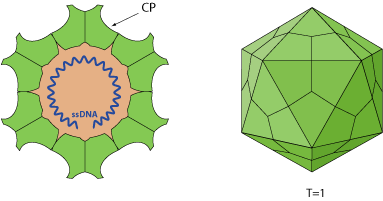Bidensovirus (taxid:1285588)
VIRION

Non-enveloped, round, T=1 icosahedral symmetry, 25 nm in diameter. The capsid consists of 60 copies of CP protein.
GENOME
Linear, bipartite ssDNA genome of about 6 kb and 6.5 kb in size, with long inverted terminal repeats. Both segments (VD1 and VD2) are encapsidated separately. Equal amount of positive and negative strands are encapsidated, so that there are 4 different types of full particles.
The genomes are replicated through rolling-hairpin mechanism.
GENE EXPRESSION
The virus code for an eukaryotic-type family B DNA polymerase. Segment VD2 codes for a structural protein in one sense and a non-structural protein at the other end on the complementary strand. Segment VD1 codes also for a structural protein in one sense and 3 non-structural proteins at the 5'-end of the complementary strand, and thus has also an ambisense organization.
REPLICATION
NUCLEAR
- Attachment to host receptors initiates clathrin-mediated endocytosis of the virion into the host cell.
- The virion penetrates into the cytoplasm via permeabilization of host endosomal membrane.
- Microtubular transport of the virion toward the nucleus.
- The viral ssDNA genome penetrates into the nucleus.
- The ssDNA is converted into dsDNA.
- dsDNA transcription gives rise to viral mRNAs when host cell enters S phase and translated to produce viral proteins.
- Replication occurs through rolling-hairpin mechanism, with NS1 endonuclease binding covalently to the 5' genomic end.
- Individual ssDNA genomes are excised from replication concatemers by a process called junction resolution.
- These newly synthesized ssDNA can either
a) be converted to dsDNA and serve as a template for transcription/replication
b) be encapsidated by capsid protein and form virions released by cell lysis.
